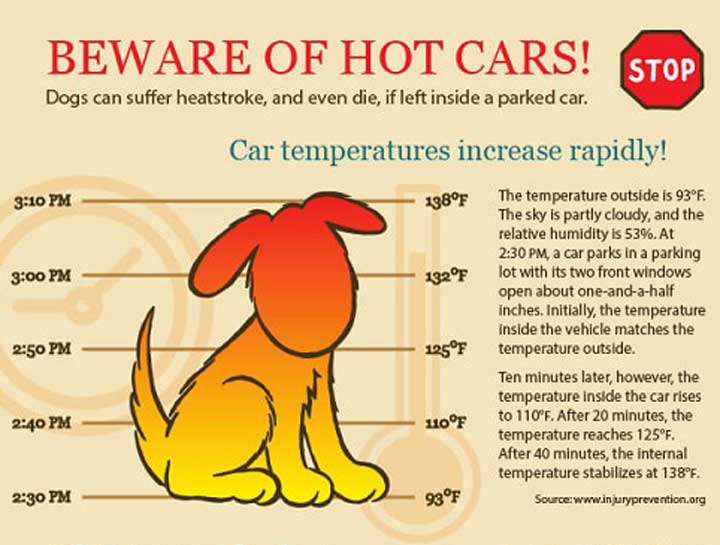Beware the Danger of Leaving Pets in a Hot Car

The temperature outside is 93°F. The sky is partly cloudy, and the relative humidity is 53%. A light-grey minivan sits in a parking lot with its two front windows open about one-and-a-half inches. At 2:30 PM, when the van is parked, the temperature inside the vehicle matches the temperature outside—93°F.
After 10 minutes, the temperature inside the car rises to 110°F.
After 20 minutes, the temperature reaches 125°F.
After 40 minutes, the temperature stabilizes at 138°F.
Question: At what body temperature does a dog start to suffer the symptoms of heatstroke?
Answer: 103°F!
Yet, a dog’s body temperature can increase much more rapidly than a car’s temperature!
Temperatures on a hot sunny day can increase rapidly
Thankfully, there were no pets or people inside that parked minivan. The van was part of an experiment to test how quickly temperatures can rise in a parked car. Even when the windows are cracked, a parked car can heat up fast!
In fact, there was a second car in the experiment with its windows rolled all the way up, and the results of the temperature testing in the second car were virtually the same as the first! So “cracking” the car windows does very little to stave off the summer heat.
In addition, dogs are much more susceptible than humans to heatstroke. It only takes 15 minutes of exposure to a 103°F body temperature for a pet to suffer permanent organ damage—or die—from a heatstroke (or from suffocation). Some pet owners who leave their pets in a parked car might say, “I’ll only be gone a minute.” But, honestly, that is a guess. We don’t want to risk the health and life of our pets on a guess!
- The single best prevention of a tragic heat stroke is to leave our beloved pet at home.
What you can do if you see a pet inside a parked car
What if we have heeded that advice, but we see that someone else hasn’t? What can we do if we see a dog that’s been left in a parked car on a hot day?
First, look to see if the dog is displaying symptoms of overheating. Symptoms include restlessness, heavy panting, excessive thirst, thick saliva, glazed eyes, rapid heartbeat, lethargy, unsteadiness, fever, vomiting, bloody diarrhea, and deep red or purple tongue.
Second, write down the car’s color, model, make, and license number. Go to the nearest businesses and have the owner of the car paged. If there isn’t a quick response, and the dog is showing symptoms, call the local animal control center or non-emergency police number. (Animal control and the police have straightforward ways of ensuring the safety of animals.) Make sure there is someone to watch the dog at all times, and don’t leave the scene until help arrives.
When the dog is rescued from the hot car, try to lower its body temperature: Move it into the shade or into an air-conditioned car or building; apply cool water (not cold water) over its whole body, or immerse it in cool water for up to two minutes (do not use ice or cold water); and/or let the dog drink small amounts of cool water or lick ice cubes. Lowering the dog’s body temperature too quickly can result in further complications.
Finally, since this is an emergency situation, please take the dog to the vet immediately.
St. Petersburg is a very pet-friendly city, and we love to take our pets with us to enjoy the sunshine. We can be a best friend to our pets by keeping them safe from the danger of hot cars.


